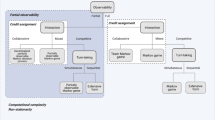Abstract
In the RoboCup soccer simulation 2D league, players make a decision at each cycle in real time. The performance of a team highly depends on the agents’ decision-making process, which is composed of a action planning method and an evaluation function of the soccer field. In this work, a cooperative action planning based on the tree search is employed. Each action is evaluated by an evaluation function. We employ a multi-layered perceptron to construct an evaluation function. We examine the performance of the soccer agents when various sets of features are used as the input of the neural network. A feature vector is made of kick sequences executed by an expert team extracted from log files. To investigate the efficiency of our approach, we compare the performance of a team using an evaluation function modeled by neural networks against a team using a hand-tuned evaluation function.






Similar content being viewed by others
References
Silver D, Hubert T, Schrittwieser J et al (2018) A general reinforcement learning algorithm that masters chess, shogi, and Go through self-play. Nature 362(6419):1140–1144
Kitano H, Asada M, Kuniyoshi Y et al (1997) RoboCup: a challenge problem for AI and robotics. In: RoboCup-97: Robot Soccer World Cup I, Springer, Berlin, pp 1–19
Akiyama H, Aramaki S, Nakashima T (2012) Online cooperative behavior planning using a tree search method in the RoboCup soccer simulation. In: Proceedings of 4th IEEE international conference on intelligent networking and collaborative systems, pp 170–177
Schmidhuber J (2015) Deep learning in neural networks: an overview. Neural Networks 61:85–117
Liu W, Wang Z, Liu X et al (2017) A survey of deep neural network architectures and their applications. Neurocomputing 234:11–26
Warnell G, Waytowich N, Lawhern V et al (2018) Deep TAMER: interactive agent shaping in high-dimensional state spaces. In: Proceedings of the 32nd AAAI conference on artificial intelligence (AAAI-18), pp 1545–1554
Stanescu M, Barriga NA, Hess A et al (2016) Evaluating real-time strategy game states using convolutional neural networks. In: Proceedings of the IEEE conference on computational intelligence and games, pp 1–7
Hong Z, Su S, Shann T et al (2018) A deep policy inference Q-network for multi-agent systems. In: Proceedings of the 17th international conference on autonomous agents and multiagent systems (AAMAS’18), pp 1388–1396
Floyd MW, Esfandiari B, Lam K (2008) A case-based reasoning approach to imitating RoboCup players. In: Proceedings of the 21st international FLAIRS conference, pp 251–256
Hausknecht M, Stone P (2016) Deep reinforcement learning in parameterized action space. In: Proceedings of the international conference on learning representations (ICLR), pp 1–12
Liu Y, Stone P (2006) Value-function-based transfer for reinforcement learning using structure mapping. In: Proceedings of the 21st national conference on artificial intelligence, pp 415–420
Akiyama H, Nakashima T (2013) Helios base: an open source package for the robocup soccer 2D simulation. In: RoboCup 2012: Robot Soccer World Cup XVI, Springer, Berlin, pp 528–535
Sugino T, Ito T, Arimura Y et al (2018) Team HillStone2018 in the 2DSimulation league team description paper. In: RoboCup2018, Montreal, Canada, pp 1–6
Akiyama H, Nakashima T, Suzuki Y et al (2018) HELIOS2018: Team description paper. In: RoboCup2018, Montreal, Canada, pp 1–6
Glorot X, Bordes A, Bengio Y (2011) Deep sparse rectifier neural networks. In: Proceedings of the 14th international conference on artificial intelligence and statistics, pp 315–323
Kingma DP, Ba JL (2015) Adam: a method for stochastic optimization. In: Proceedings of the 3rd international conference on learning representations (ICLR), pp 1–15
Author information
Authors and Affiliations
Corresponding author
Additional information
Publisher's Note
Springer Nature remains neutral with regard to jurisdictional claims in published maps and institutional affiliations.
About this article
Cite this article
Fukushima, T., Nakashima, T. & Akiyama, H. Evaluation-function modeling with multi-layered perceptron for RoboCup soccer 2D simulation. Artif Life Robotics 25, 440–445 (2020). https://doi.org/10.1007/s10015-020-00602-w
Received:
Accepted:
Published:
Issue Date:
DOI: https://doi.org/10.1007/s10015-020-00602-w




